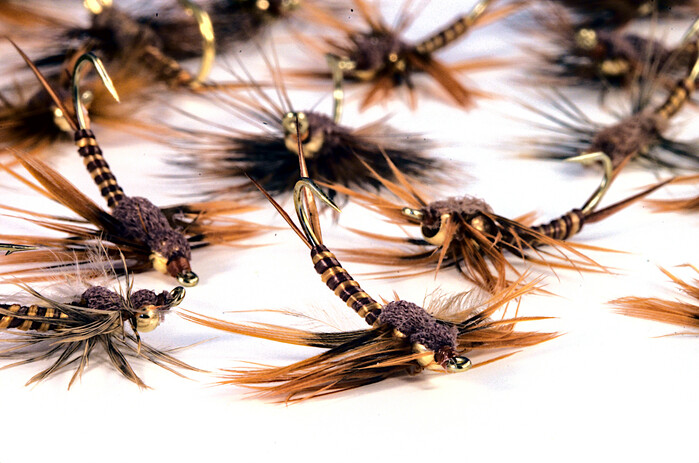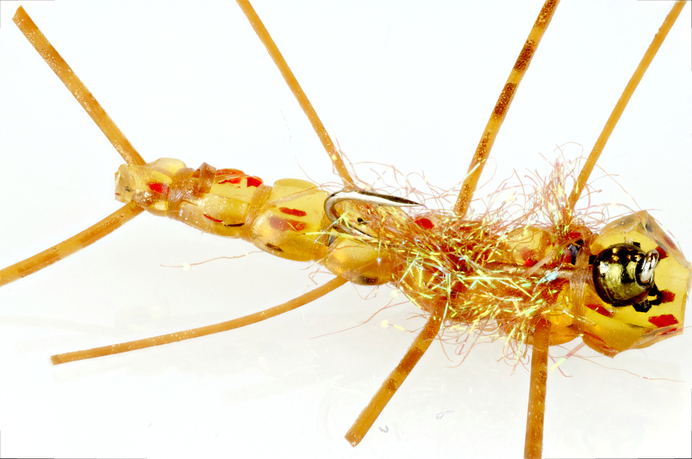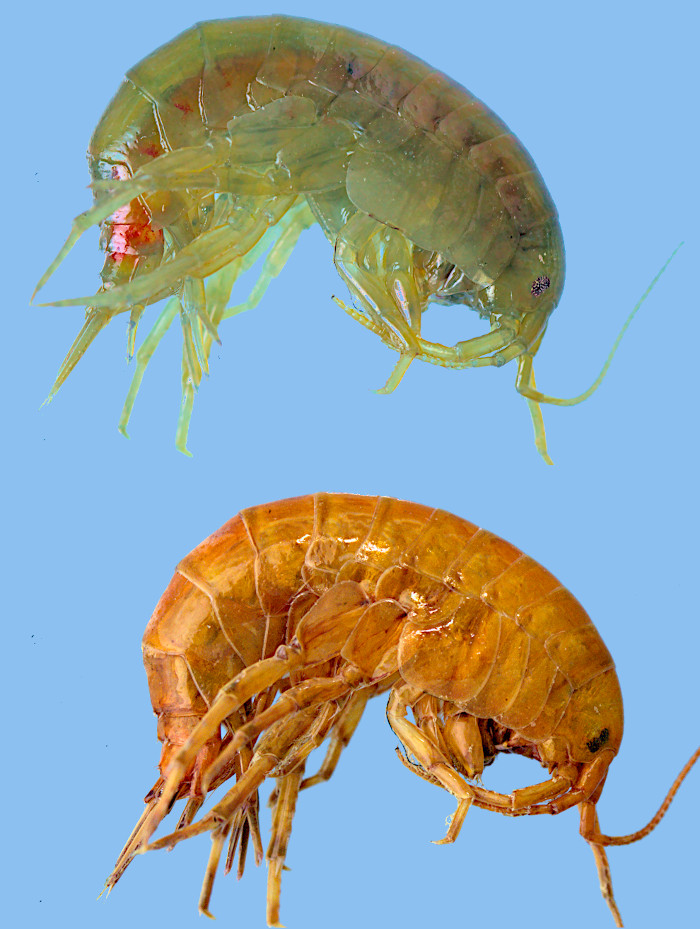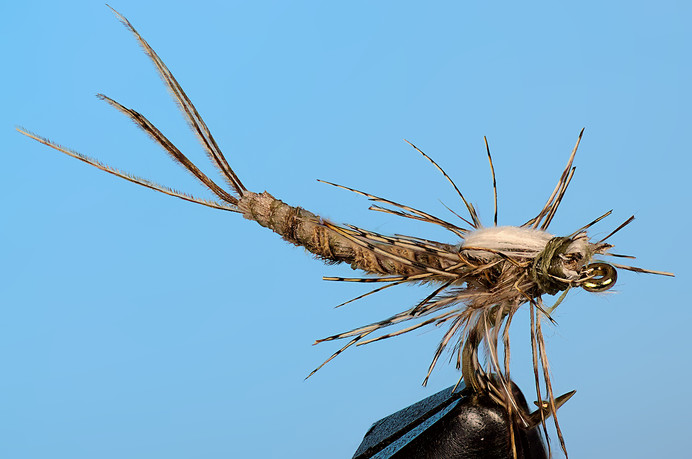Nymphs and Wet Flies
I don't think of nymphs as different than wetflies. I don't tie or fish old-fasioned winged wetflies much, not often anyway, and the Soft Hackle and Hair Hackle wets I do use I fish the same way as nymphs, and visa versa. Someone once told me "You swing wet flies and dead drift nymphs." I sometimes swing and sometimes dead drift everything including streamers wet flies and nymphs. So in my case nymphs and wet flies amount to feathery variations of the same thing. What about a Woolly Worm? Is that a streamer or a fat nymph? Terminology can be vague and misleading.
Dead drift refers to the idea of a fly moving in the water as if it was not connected to a leader, even though it is. Swinging a fly usually means casting upstream and across and then swinging the fly across the currents with the rod tip pointing up while the line is held tight by your free hand. A swinging fly absolutely is a dragging fly. Rules can be misleading too. G.E.M Skues--the father of nymph fishing--has some interesting thoughts about the draggin fly:
Of all trials of the chaulk-stream angler, perhaps drag is the worst. Yet even drag can be made use of on occassion, to add to the weight of the creel.
Dead drifted nymphs are often essential. Swinging nymphs and wet flies can be deadly. So is a judicious combination of intuition and experimentation. Rules and assumptions are all too often counter-productive.
My Menagerie
Brassies and buzzers of all kinds including the Zebra Midge and Laser Midge, Pheasanttails, Generic Flashback Nymphs, Crane Fly Larva, Green and Brown Rock Worms, the Prince Nymph, Gold Ribbed Hare's Ear, Don Martinez Black Nymph, Three Dollar Dip, Don Juan Worm, Soft Hackle Wet Flies, Scuds, Jellystone Nymph, Marshmallow Nymph and Pott Sticker are flies I try to keep in my boxes at all times. I'm a fly tier. I have other patterns too. Lots of them. But the list above is what I rely on. If I don't have those in my fly boxes I know I need to get busy. Anything else is probably an experiment.
Midges
Buzzers--midge larvae of all kinds--are an early season staple. I've had good midge fishing at the Raynold's Pass Bridge on the Madison in early March when the snow was three feet deep. Icy trails down to the water at the base of the bridge provide wading access upstream and down on a warm day--where warm means anything above freezing for me. You have to be careful about downstream. If you lose your footing and fill your waders with icy water the only way to get home alive is to wade back upstream because the snow banks are too high to climb. Upstream is safer. If you lose your footing upstream you can waddle back downstream with the current instead of against it, cuss a few times and crawl out. I like to fish black-bodied dry fly midges that have a white, foreward-slanting tuft of some kind so I can see the fly, with a Brassie or a Zebra Midge trailing behind. Lots of fishermen use the Griffith's Gnat for midgeing. I seldom do for some reason. Habits are hard to change when you are old. Midge fising on the spring creeks can be spectacular too and the Winter rod fees are cheap. So too for the best of the big tailwaters. If it's early in the year and the midges are not happening you can always dead drift streamers, deep over "Winter Water" which is deep slowly-moving water with a gravel rather than silt bottom.
Midge fishing isn't just about March however. There are always at least a few midges around, expecially late in the day. On one of my favorite tailwaters, way down low on the river at the mouth of a canyon, at Pale Morning Dun time the fish usually start to dimple again at sundown, long after the mayflies have finished. For me that usually means rowing a last few channels above the boat takeout. When it's almost dark it's hard to tell exactly what's going on visually, but it's still not a mystery. At sundopwn PMDs stop working and midges do.
The Laser Midge
The most amazing new nymph in my adult life came from my now departed fishing buddy Willy Self: the hot flourescent orange Edge Bright Laser Midge . This truly is a magic fly. Why is not clear. It may be just the color. Willy's favorite dressing continually changed. Sometimes it had a Serendipity-like white Widow's Web tuft on top. Sometimes a single wind of Partridge or hen hackle. Willy tied what he called Annelids too, which were a bit like San Juan Worms tied with a hot fluroescent orange Edge Bright body. Willy's Edge Bright Flies worked all year long but they were clearly at their best in the early season, from March through to the end of Spring runoff in Montana. They work everywhere, in Spring Creeks, big rivers and at the edges of the big reservoirs.
Nymphing
More traditional nymphs from size #10 to #14 and even #16 are spot on in early Summer when the water first starts to clear after the runoff. I don't tie all my nymphs with beads up front, but I do for most of them. Early Summer bobber fishing from a driftboat is increasingly popular in recent years. I've done it, I'm no Saint. But I do prefer not to, not because of any Halfordian moral posuturing but because I catch more fish with two nymphs and no bobber. It's easier to control depth without a bobber or a hopper dropper rig. I jiggle the line frequently to keep it relatively straight, in between "let it sink" moments. And I set the hook frequently too. Was that a strike? Was that a strike? There is only one way to find out. You have to set the hook. I tie Pheasanttails mostly in small sizes as spring creek flies. For the big rivers I stick with the four horsemen: The Prince, Hare's Ear, Martinez Black Nymph and Flashback Nymphs. Whether I use a black bead or a gold bead depends mosly on what my fingers find first at tying time.
When fishing from a drifting boat river real estate opportunities are greatly expanded but your attention span is limited. You only get one shot at every holding spot parading by. If you anchor up and get out of the boat to fish riffle-pool areas, or if you are wading all day anyway, you can fish more seriously. Every river is a bit different. The Madison upstream from Ennis is a never ending series of runs and riffles with not many real pools. The Yellowstone in the upper end of the Paradise Valley looks like an all day nymph run. Lower down closer to Livingston the river is all about pool-drop riffle, pool-drop riffle. In those habitats it really pays to wade rather than drift. If the fish are active and feeding you can find them above the pools, feeding in the riffles. Medium to small size beadheads will be the most productive. Tie on your favorite nymph and run with it. The Prince Nymph is hard to beat. That nearly a century old pattern is still going strong for a reason.
If the fish are not flashing on small nymphs drifted in the riffles look a little further down in the slightly smoother but still rolling water at the base of riffle. If you've still got a Prince or a Black Nymph or a Hare's Ear on see what heppens there. If that doesn't work it's time to try a stonefly nymph, a little deeper. Not counting shooting heads depth comes from weight which might be on the fly or on the leader. Weight on the leader could be a pair of BBs 18" up the leader from the fly or it might be a heavier sparkplug fly. When you have a driftboat achored up nearby there might be counter productive psychological pressure to fish quickly and move on. Take your time. Never leave any riffle-drop pool area without swinging a fluffy nymph or a streamer at the tailout. Streamers and bigger nymphs ca be fished extra-deep and extra-heavy in the middle of the pool, or a little lighter at the tailout. The tailouts do not always hold fish but when they do the fish there are looking for a meal. Of all the rivers I fish the Big Horn is the furthest away and the one I know least well. I do know on the Big Horn I'm the most likely to find foraging brown trout, at the tailouts. The Big Horn can get crowded during prime season. At the heads of the pools there it's common to find one or two boats parked in front of you. The tailouts are usually fair game.

Rock Worms
Northern Rocky Mountain flies imitating various caddis larvae and pupae are often referred to as Rock Worms. These are big time important flies for me. I'll defer talking about Rock Worms until a on Caddis a few pages later.
Stonefly Nymphs
When I get my feet wet the first thing I do is look things over. If there is an aquatic insect event happening I'll target that, with dry flies or emrgers or what ever seems best. Intuition and impulse guide me more often than anything resembling logic. If I don't see dimpling fish, and depending on weather conditions and time of year, I might consider a generic dry fly like a Troth Elk Hair Caddis or a hopper of some kind. Else it's usually all about wet flies and streamers. Choosing between wet flies and streamers gets complicated. Choosing between smaller wets and bigger stoneflies is easier. I try smaller first and then go bigger and deeper if I have to. Beyond that I usually do not make any real analysis. I go with the flow and run with my gut instinct.
Stonefly nymphs are indecision's best friend. If I'm in cold clear fast water I'll probably try a dark Pteronarcys nymph of some kind. The Pteronarcys (Rocky Mountain Salmon Flies) have a three year life cycle, so all sizes are in the water at any given time. I usually start with big and then switch to smaller if that doesn't work. My dark stonefly nymph of choice is always a Marshmallow Nymph. I'll talk more about about Marshmallow Nymphs in a subsequent page.
Jellystone Nymph
If I'm fishing further down the river or if the dark stoneflies are not working I'll almost always choose a Jellystone Nymph. People sometimes ask me "What is your best fly?" I have a lot of oddball patterns. Many are no better than their more traditional counterparts but they aren't any worse either, so I choose my own just because they're mine. The Jellystone is different. The Jellystone is better, better than almost any other stonefly nymph. If I had to choose one fly I called my best pattern the Jellysone Nymph would probably be it. The Jellystone is a magic, all-around, works eerywhere fly, in cold fast water or further down the river where the temperatures are a bit higher and the bottom i siltier. Pteronarcys nymphs are stream bottom detritus eaters. They cannot survive without clear cold well-oxygenated water. Golden Stoneflies are carnivores. They can tolerate higher water temperatures and they range far further down the water shed. Montana fish eat Golden Stoneflies. They seem to like my Jellystones a lot too. Like Marshmallow Nymphs, Jellystones are soft and squishy to the touch. Fish bite down hard and do not let go. That makes actually catching fish an order fo magitude easier.
Jellystones are made on a horizontal needle, after snipping a body blank out of a bass fisherman's tube lure. I posted a photo of a Jellystone on an internet discussion forum once and was immediately challenged by an outraged purist who announced he "would have me arrested and jailed" if I ever used my fly on his favorite fly fishing only water in Oregon. Phew. In Montana there is no such thing as fly fishing only. This is more than a bit weird. For one thing big stoneflies are not a good choice for fly fishing only spring creeks anyway. But more to the point, Jellystones are made from much the same material as a foam grass hopper. The only difference between a Jellystone and a foam hopper are the air bubbles molded into the foam. Why would one fly be banned and the other celebrated? There is a generational cultural shift at work here. I've met lots of promisiing young tiers at fly tying nights in the local fly shops recently. I have not yet to meet any stick-waving young purists.

Scuds
Scuds are mostly about spring creeks and tailwater rivers but they exist in big freestones too, if and only if there are weeds. Live scuds camouflage themselves by adopting a light to sometimes dark olive coloring that matches the aquatic weeds they live in. When they die, for what ever reason, they turn bright orange quickly. I haven't kept records or a diary. I know some people do. But after a lifetime of fishing I think I can confidently say I've had better success with orange scuds than green ones. Scud fishing mostly happens on spring creeks or tailwaters. In those places, if there is an aquatic insect event happening I go with that flow. But if there is no hatch there are a lot of prospecting choices to choose from. Scuds are hard to beat.

Experiments
My old and now departed fishing buddy Willy Self must have had 300 or more nymph patterns. In his meticulously organized boxes he liked to keep six or more of each pattern side-by-side. The maybe 16 or less patterns I listed above would get me through the season without feeling deprived--if I had them all. But I seldom do. I spend most of the Winter experimenting with new ideas. When it comes time to actually fish, when I put my boxes together the night before a trip I almost always find I'm missing half of what I need. Staying up late and feaverishly tying what I need for tomorrow is one of my favorite passtimes.

Notes:
Now, in nymph fishing your hook must be exceedingly sharpmore fish are lost because of dull, cheap hooks than all other causes combined James Leisenring